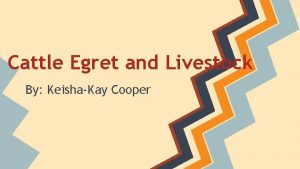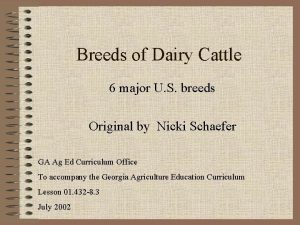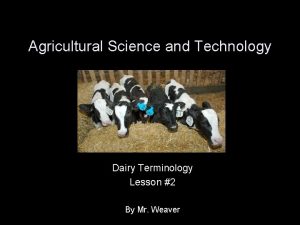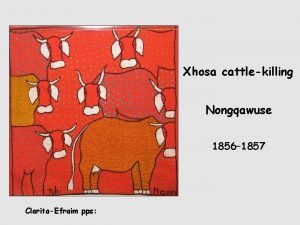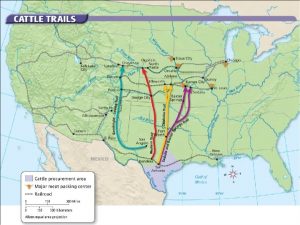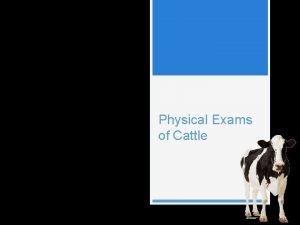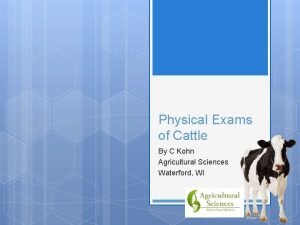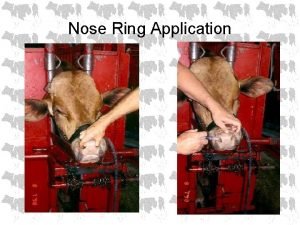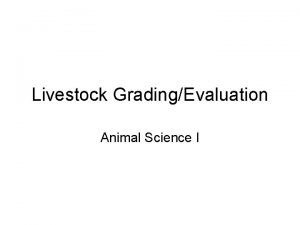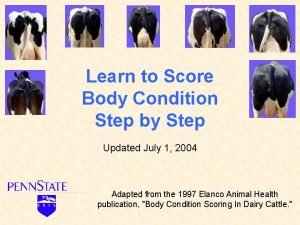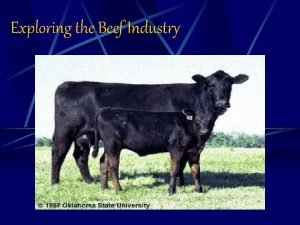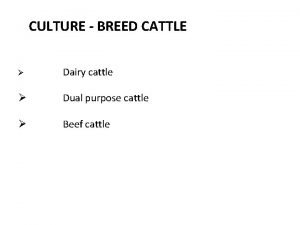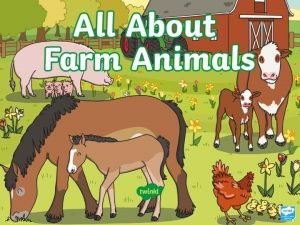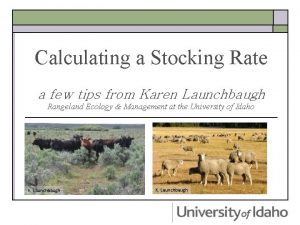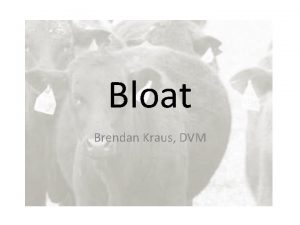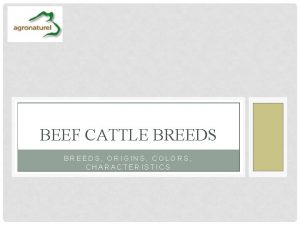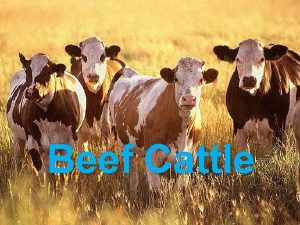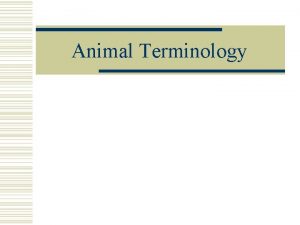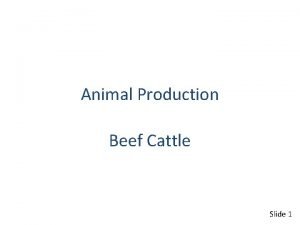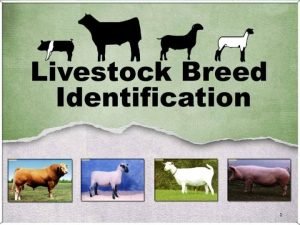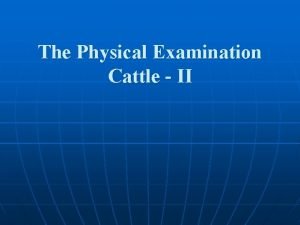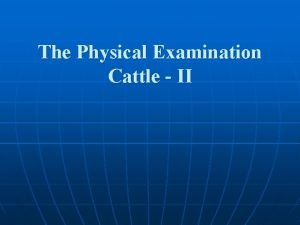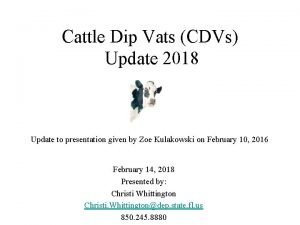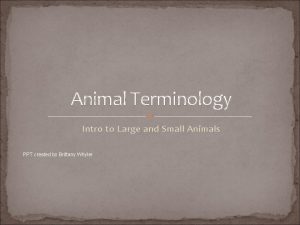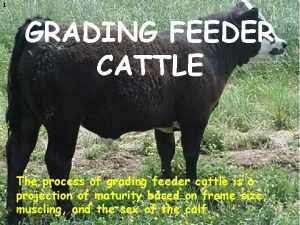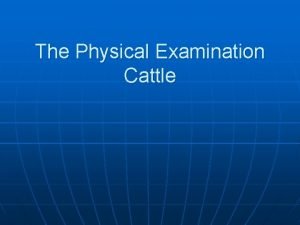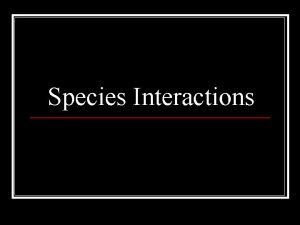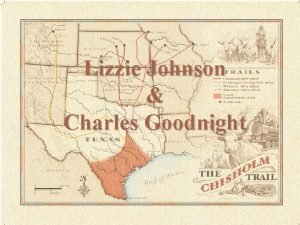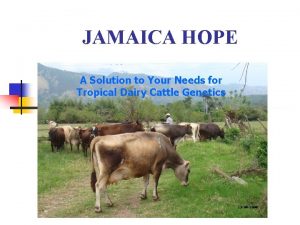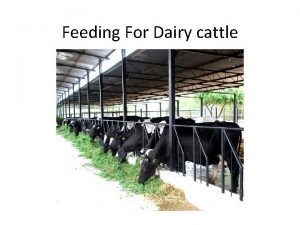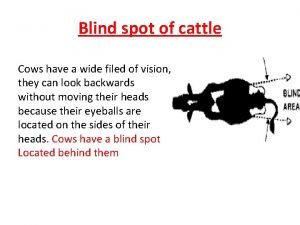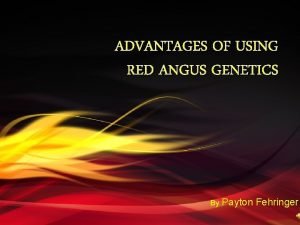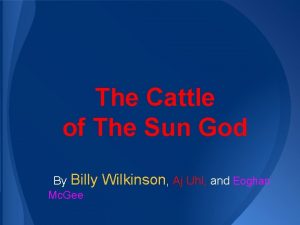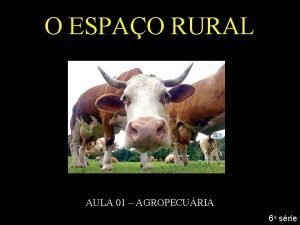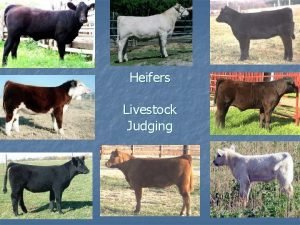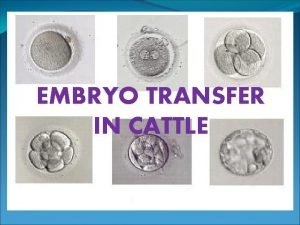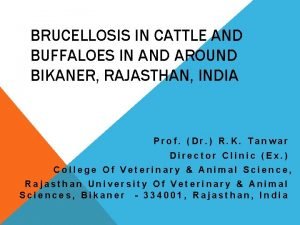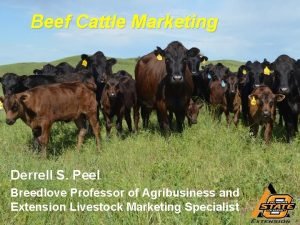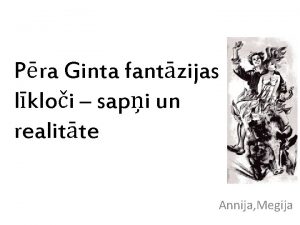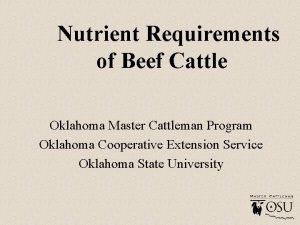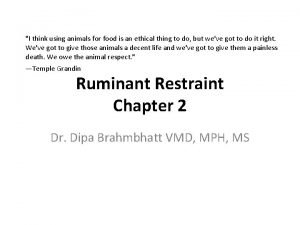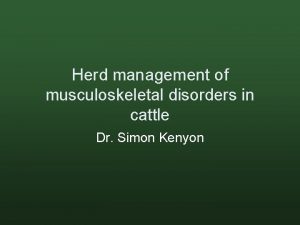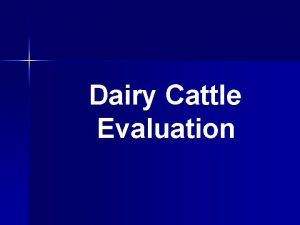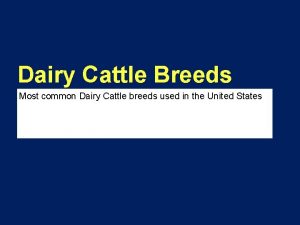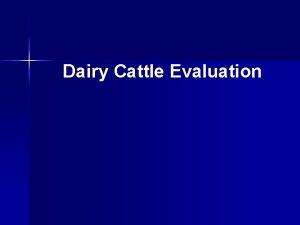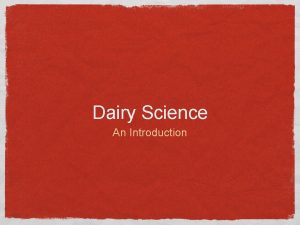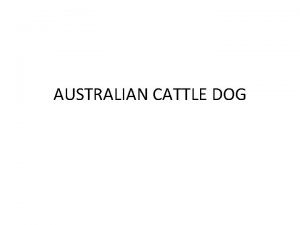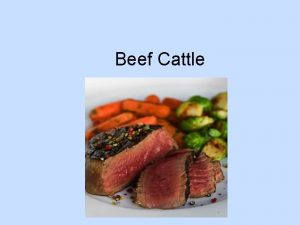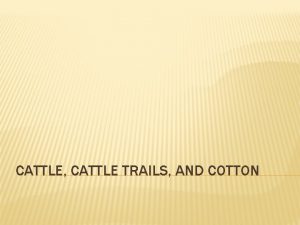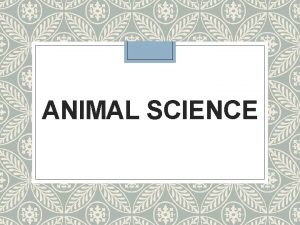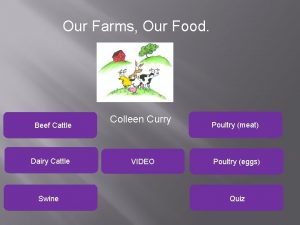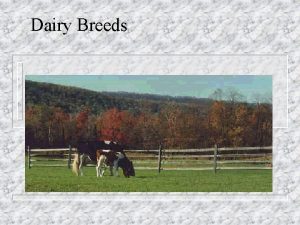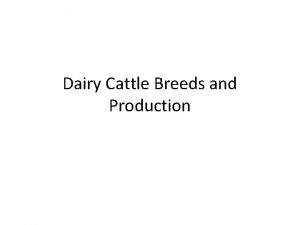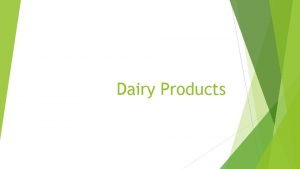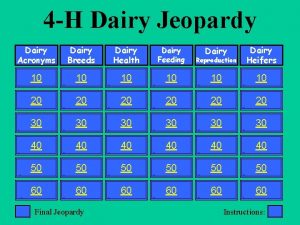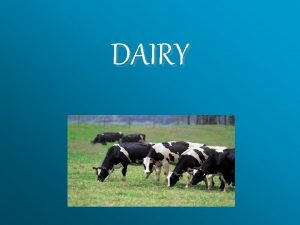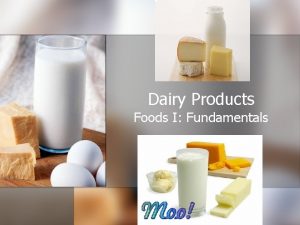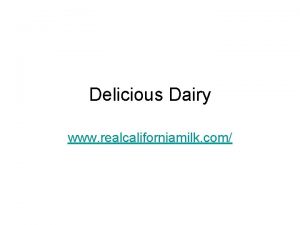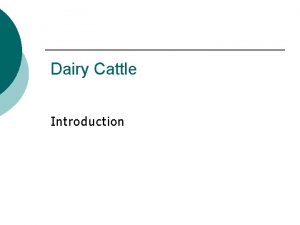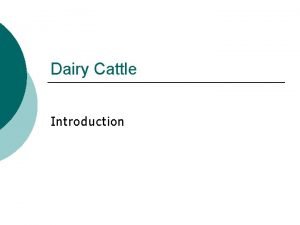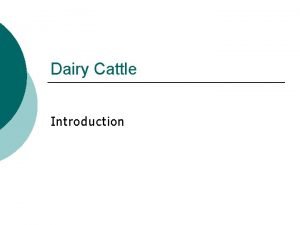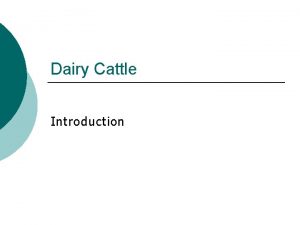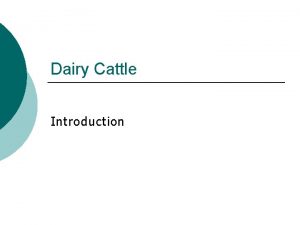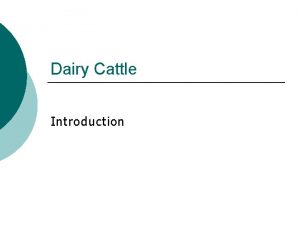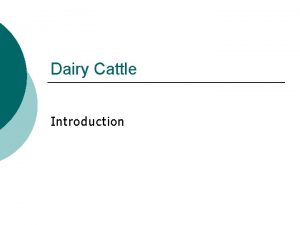Dairy Cattle Introduction Know Understand Do Know Types






































































- Slides: 70

Dairy Cattle Introduction

Know Understand Do! Know ¡ Types of Dairy Cattle ¡ Industry Procedures ¡ Care Procedures Understand Do Variation in Profile Dairy cattle purposes Cattle Milking and Outline Milking Dairy Food ID common Processing Diseases Disease Prevention Methods

Dairy Cattle Breeds

Warm-up ¡First thing that comes to mind when you see….

Lesson Essential Question ¡How are Dairy Breeds Selected?

Holstein ¡ Dominate the industry l +90% of the dairy cattle in the US ¡ Officially known as Holstein-Fresians ¡ From Netherlands and Northern Germany Arrived in US in mid-1800 s Typically black and white in color Total milk solids % are lower ¡ Solids refer to milk fat solids found in milk. These are used to determine quality and use of the milk produced by that breed of cattle ¡ ¡ ¡

Holstein

Jersey ¡ ¡ 2 nd in popularity Developed on the island of Jersey, off the coast of France First imported early 1800 s ¡ Coat color ranges from light tan to almost black ¡ Ability to efficiently convert feed to milk ¡ Lower body maintenance needs ¡ Amount of milk produced per cow is lower ¡ Total solids %- highest of all breeds ¡

Jersey

Brown Swiss ¡ ¡ ¡ 3 rd most popular Originated Switzerland Came to US in mid-18002 Normally brown to gray ¡ Similar to Holsteins in size ¡ Known for ability to produce milk in hot climates ¡ 2 nd in milk production ¡ Total solids % in middle of all breeds ¡

Brown Swiss

Ayrshire ¡ ¡ ¡ Red and white Imported early 1800 s Milk production midrange of all breeds Total solids % low Originated Ayr district of Scotland

Ayrshire

Guernsey ¡ ¡ ¡ Developed Island of Guernsey (coast of France) Imported early 1800 s Medium sized red and white breed ¡ Golden Guernsey milk lower in total solids then Jersey milk ¡ Deep yellow/golden milk due to beta carotene (precursor to vitamin A)

Guernsey

Milking Shorthorn 3, 150 in 2008 ¡ Originated from base stock of beef shorthorns and may be red, white, red and white or roan. ¡ Known for high levels of fertility, grazing efficiency, and ease of management ¡

Milking Shorthorn

ID- Tell me what breed the picture is

ID- Tell me what breed the picture is

ID- Tell me what breed the picture is

Dairy Judging for Production ¡ Competition between farmers l ¡ Compete for money and prestige within the industry Dairy Cattle Judged On: l Physical Appearance ¡ ¡ Fore legs, Rear Legs, Utter, Hooks, Pins, Top Line (Spine) Other areas to consider when choosing cattle for production: l Mothering ability, efficiency on feed and grass, Quality of Milk, Milk solids and fat

Dairy Cattle Dairy Industry Overview

Warm-up ¡What do you think of when you see this?

Essential Question ¡ How is the Dairy industry so efficient ?

Dairy Cattle Industry Most difficult to manage ¡ High producing dairy cows bred to give large amounts of milk that can overwhelm the animal without proper management ¡ Value of dairy products exceeded $37 billion nationally ¡ Most labor intensive l Milking 2 -3 times a day, 7 days a week ¡ ¡ Consumer demand lower fat diets Food scientists respond with specialty items Ex: Fat-free yogurt, cream cheese, and frozen dairy deserts


Dairy Cattle Industry ¡Rank top 5 in Production- l California l Wisconsin l New York l Pennsylvania l Idaho

Dairy Cattle Milking

Milking ¡Cows are milked 2 times a day, some 3 times

The Milking Process ¡ 1. At milking time, wash the teats, wear gloves l. Disinfecting the teats and triggers the release of oxytocin, which initiates milk let-down

The Milking Process

The Milking Process ¡ 2. Teats are then dried with individual paper towels

The Milking Process

The Milking Process ¡ 3. One inflation of the milking claw is placed on each teat or quarter

The Milking Process

The Milking Process ¡ 4. Vacuum applied to claw, which draws the milk from the udder. Flow meter determines amount of milk being produced by cow

The Milking Process

The Milking Process ¡ 5. When milk stops, flow meter reads 0 milk intake and milking claw falls off automatically

The Milking Process ¡ 6. Each teat is then dipped in Iodine to prevent bacterial invasion ¡Total time: 7 minutes

The Milking Process

Now What? ¡ Milk from all cows is collected into a large vat (holding container) l ¡ Normally underground to protect from extreme temperatures Milk is transferred to a transport truck and taken to the processing plant.

Dairy Cattle Parasites and Diseases

Warm-up ¡What does this explain?

Lesson Essential Question ¡How can disease influence the dairy industry?

Mastitis ¡Infection and inflammation of the udder ¡Causes greatest economic loss to the industry ¡Acute-hot, swollen udderdrop in milk production ¡Treated with antibiotics

Ketosis ¡Metabolic disorder with a negative energy balance ¡Caused by underfeeding, stress, other infections ¡Treated by IV of glucose injections

Displaced Abomasum ¡“twisted stomach” ¡When abomasum moves to an abnormal position ¡Caused by feeding too much silage or concentrate before calving ¡Veterinarian consulted for treatment

Milk Fever ¡Imbalance of calcium ¡muscle paralysis and prevents cows from standing ¡ calcium and phosphorus supplements to prevent ¡Treated with infusion of calcium salts

Retained Placenta ¡Placenta not expelled after birth ¡Quickly become infected ¡Vet remove or allow it to hang and it will release ¡Caused by heat stress, low vitamin E, and selenium in bloodstream

Metritis ¡Resulting infection of a retained placenta ¡Abnormal discharge from vulva, go off feed, and stand with backs arched ¡Antibiotics treat

Dairy Cattle Anatomy

Warm-up ¡How is a dairy cow able to produce so much milk?

Lesson Essential Question ¡What are the parts of a dairy cow?

Anatomy

Anatomy: Udder Cows udders have four compartments with one test hanging from each l Cells remove water and nutrients and convert it to milk The milk drips into a cistern which holds the milk When teat is squeezed, milk is released l l l

Anatomy: Oral l l Mouth is adapted for grazing Top part of mouth is a hard pad Bottom part is a row of flat-topped teeth Grind food between two parts

Anatomy

Stomach and Digestion l l 4 parts Cows swallow their food and then regurgitate a “cud” which is then chewed well and swallowed Rumen- largest part, holds up to 50 gallons of partially digested food l Good bacteria here help break down Reticulum- if cow eats something it shouldn’t have, it goes here l Where ‘cud’ comes from

Stomach l Omasum- the filter. Some water absorbed ¡ Filters through all the food the cow eats. ¡ Cud is pressed and broken down further ¡ l l Abomasum- this part like the humans stomach l “True Stomach” l Food is finally digested here l Essential nutrients are passed to the bloodstream Remainder passed to the intestines

Digestion in Ruminants 10 Step Program ¡ ¡ ¡ ¡ ¡ 1. Forage- Find food 2. Masticate- Chew Food 3. Swallow 4. Rumen: Food fermented and broken down 5. Reticulum: cud thrown up into mouth 6. Remastication: rechewed and re swallowed 7. Omasum: food broken down more, some water absorbed 8. Abomasum: True Stomach, digestion starts here 9. Intestines 10. Out as manure

Dairy Cattle Management

Warm-up ¡ Why might we use these types of housing?

Newborn and Young Calves Housing Individual stalls, inside or outside l Better ventilation outside ¡ Less respiratory disease l Calf hutches popular after weaning At 8 weeks, heifers normally grouped with other heifers of similar age Separate heifer growing barn Open front sheds are also popular ¡ ¡

Traditional Housing: One year + l Tie-stall barns- tied to individual stalls during milking and the rest of the day released into pasture at night in summer l Free-stall housing- allow cows to enter and leave as they wish. Feed bunk at center. Milked in tie-stalls or a milking parlour

Traditional Milking l l l Parlour System- cows come to the milker. Group enters at a time- udders at chest level for milker in a pit. All cows washed and milked at same time. Increase # of cows a person can milk per hour Robotic Milking system- reduce milking labor requirements. Allow cows access 24 hours a day. Sensors

Robotic Milker “anatomy”

Calf Care/Nutrition l Starts within 24 hours of birth ¡ l l l Colostrum- first milk Calves are weaned immediately after receiving colostrum Cows returned to the milking herd after parturition l Parturition- giving birth in cows Calves raised by humans Replace milk with water gradually 12 weeks to 1 year- fed a grain mix

Heifer Nutrition l l Heifer: Female who has not given birth yet (1 to 2 years old) After breeding, heifers fed free-choice, high-quality forage ¡ Grain mix may be added to ensure proper development and provide minerals and vitamins since farmer is “hoping” heifer is preg ¡ High protein food allows for cow to “carry” her calf nutritionally

Lactating Dairy Cows Lactating: producing milk l Lactating cows require high quality food to sustain good milk production l Normally lasts about 10 months l Nutritional needs dependent on body size and milk production l Cows are “dry” (milking stopped) about 60 days before the next expected calf l ¡ Dry cow: not producing milk. This is a “rest” period

Dry Dairy Cattle l Cows are “dry” (milking stopped) about 60 days before the next expected calf ¡ Dry cow: not producing milk. This is a “rest” period l Dry cows fed a diet of forages. Not high quality l Often fed grain to provide vitamins, minerals and salt
 Cattle egrets and livestock
Cattle egrets and livestock 6 breeds of dairy cattle
6 breeds of dairy cattle Dairy cattle terminology
Dairy cattle terminology To understand recursion you must understand recursion
To understand recursion you must understand recursion Kud meaning education
Kud meaning education Know vs understand
Know vs understand Kristina doubet
Kristina doubet Dairy products introduction
Dairy products introduction Know history know self
Know history know self Normalizing flow
Normalizing flow I'm holding on to your promises you are faithful
I'm holding on to your promises you are faithful Nongqawuse
Nongqawuse Xhosa cattle killing outcome
Xhosa cattle killing outcome Texas cattle drive map
Texas cattle drive map Burley method of casting
Burley method of casting Wither pinch test
Wither pinch test Withers pinch test in cattle
Withers pinch test in cattle Master cattleman program
Master cattleman program Vagus indigestion in cattle
Vagus indigestion in cattle Slaughter cattle grading classes
Slaughter cattle grading classes Sacral fat pad
Sacral fat pad Beef cattle parts
Beef cattle parts Conveyor belt cattle feeder
Conveyor belt cattle feeder Dual purpose cow
Dual purpose cow What cows give us
What cows give us Calculate stocking rate
Calculate stocking rate Treatment for bloat in cattle
Treatment for bloat in cattle Frame score cattle
Frame score cattle Hooks and pins on cattle
Hooks and pins on cattle Beef cattle characteristics
Beef cattle characteristics Origin of beefmaster cattle
Origin of beefmaster cattle Mature male cattle
Mature male cattle Reproduction in animals
Reproduction in animals Beef cattle growth curve
Beef cattle growth curve Amerifax cattle
Amerifax cattle Wither pinch test
Wither pinch test Grunt test cow
Grunt test cow Linnaean classification rabbit
Linnaean classification rabbit Range cattle research and education center
Range cattle research and education center Sodbusters apush
Sodbusters apush Some natural resources such as wheat and cattle are
Some natural resources such as wheat and cattle are Cattle dip vat
Cattle dip vat Simbrah cattle disadvantages
Simbrah cattle disadvantages Group name for cattle
Group name for cattle Feeder cattle grading
Feeder cattle grading What contribution did mexicans make to cattle ranching?
What contribution did mexicans make to cattle ranching? Cow physical exam
Cow physical exam Eurylochus odyssey
Eurylochus odyssey 5 major types of species interactions
5 major types of species interactions When was lizzie johnson born
When was lizzie johnson born Jamaica hope cow
Jamaica hope cow Cattle feed products
Cattle feed products Anti cow kicker and tail holder
Anti cow kicker and tail holder Disadvantages of red angus cattle
Disadvantages of red angus cattle Feedlot design and construction
Feedlot design and construction Cattle of the sun god
Cattle of the sun god Cattle gif
Cattle gif Cattle hedging strategies
Cattle hedging strategies Beef cattle judging practice
Beef cattle judging practice Disadvantages of embryo transfer in cattle
Disadvantages of embryo transfer in cattle Difference between crao and crvo
Difference between crao and crvo Cattle
Cattle Beef cattle marketing strategies
Beef cattle marketing strategies The molecule dna contains the four bases listed below.
The molecule dna contains the four bases listed below. Pēra ginta zirgs
Pēra ginta zirgs Nutritional requirements for beef cattle
Nutritional requirements for beef cattle Cattle terminology
Cattle terminology Rope squeeze method of casting
Rope squeeze method of casting Laminitis in cattle
Laminitis in cattle Dada
Dada What factors led to the
What factors led to the
